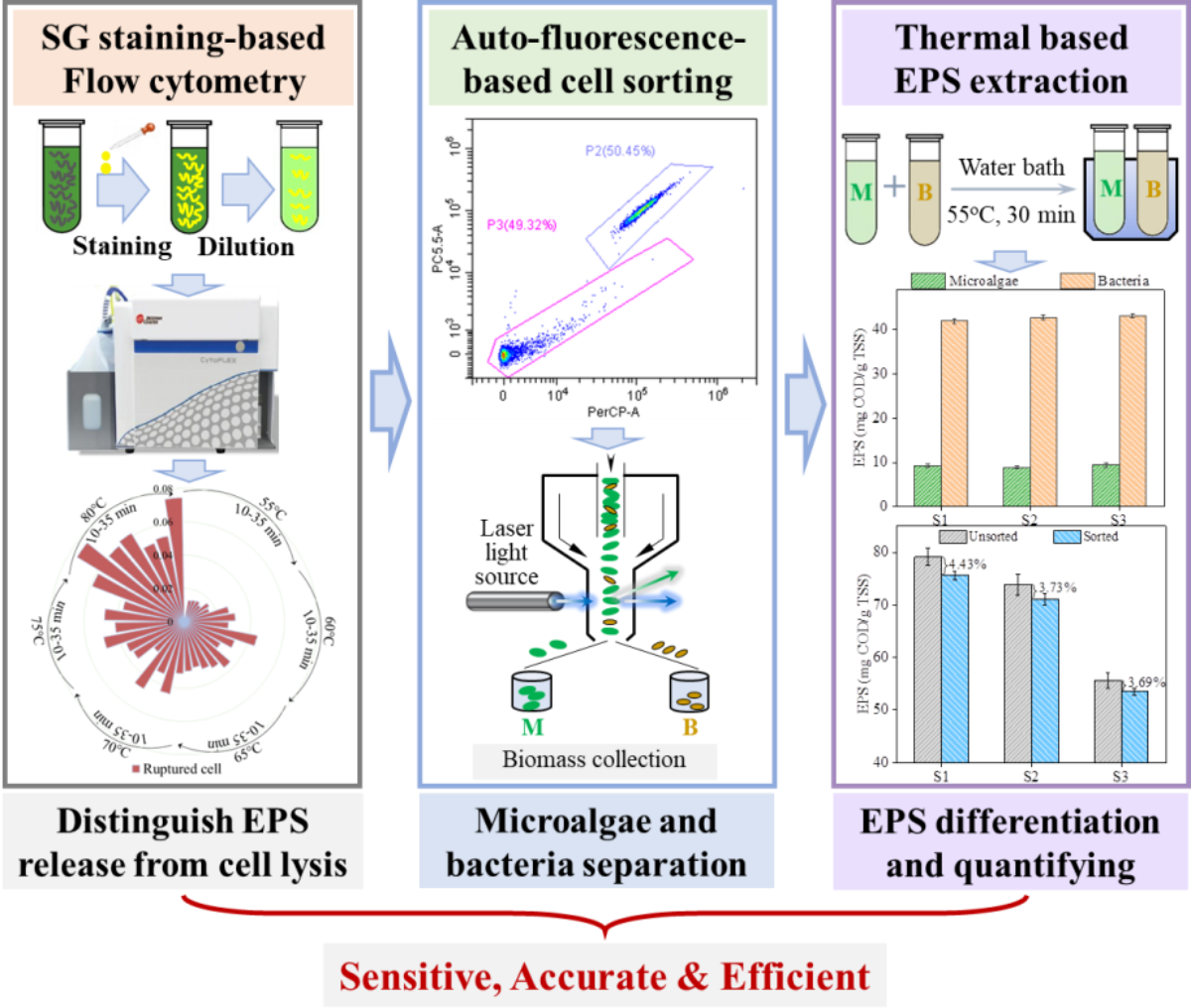南湖新闻网讯(通讯员 任恬)4月17日,我校资源与环境学院污水处理与资源化团队在藻菌共生系统微藻和细菌胞外聚合物定量分析方法构建的最新研究成果以“Differentiation and quantification of extracellular polymeric substances from microalgae and bacteria in the mixed culture”为题在Water Research上发表。
藻菌共生系统具有高效除污、高稳定性、易操作低成本和环境友好等优点,在污水处理、生物资源利用以及环境改善等领域具有广泛的应用前景。胞外聚合物(EPS)对微藻-细菌聚集体的形成和功能具有重要影响。理解EPS的关键作用依赖于可靠的提取和准确的量化方法。然而,从微藻-细菌聚集体中提取、评估、区分和量化EPS具有极大的挑战性。
基于此背景,团队采用热提取和阳离子交换树脂处理从微藻-细菌混合液中提取总EPS,结合SYTOX Green染色和流式细胞仪来评估EPS提取过程中的细胞破裂情况;在不同微藻/细菌质量比下提取总EPS,以此来验证提藻菌系统总EPS最佳取方法的普遍适用性;运用基于自发荧光的流式细胞分选(AFCS)来分离和收集混合液中的微藻和细菌,采用AFCS结合热处理实现共生体系的微藻和细菌EPS的提取和量化。

图1 藻菌混合液中微藻和细菌胞外聚合物提取及定量分析方法的构建和评估
本研究通过优化提取条件和定量分析方法,成功探索出一套适用于研究微藻-细菌混合液中EPS区分、提取及量化的方法,丰富了藻菌共生系统的研究内容,为进一步挖掘EPS在藻菌共生系统污水处理中的重要作用提供了有力支持。
研究得到国家自然科学基金项目和华中农业大学高层次人才项目资助。我校资源与环境学院硕士研究生任恬为论文第一作者,周云教授为论文通讯作者。资源与环境学院博士研究生崔晓彩、伍贝贝和美国工程院院士、亚利桑那州立大学斯威特环境生物技术中心主任Bruce E. Rittmann也参与了研究工作。
【英文摘要】
Extracellular polymeric substances (EPS) play significant roles in the formation, function, and interactions of microalgal-bacteria consortia. Understanding the key roles of EPS depends on reliable extraction and quantification methods, but differentiating of EPS from microalgae versus bacteria is challenging. In this work, cation exchange resin (CER) and thermal treatments were applied for total EPS extraction from microalgal-bacteria mixed culture (MBMC), flow cytometry combined with SYTOX Green staining was applied to evaluate cell disruption during EPS extraction, and auto-fluorescence-based cell sorting (AFCS) was used to separate microalgae and bacteria in the MBMC. Thermal extraction achieved much higher EPS yield than CER, but higher temperature and longer time reduced cell activity and disrupted the cells. The highest EPS yield with minimal loss of cell activity and cell disruption was achieved using thermal extraction at 55℃ for 30 min, and this protocol gave good results for MBMC with different microalgae:bacteria (M:B) mass ratios. AFCS combined with thermal treatment achieved the most-efficient biomass differentiation and low EPS loss (< 4.5%) for the entire range of M:B ratios. EPS concentrations in bacteria were larger than in microalgae: 42.8 ± 0.4 mg COD/g TSS versus 9.19 ± 0.38 mg COD/g TSS. These findings document sensitive and accurate methods to extract and quantify EPS from microalgal-bacteria aggregates.
论文链接:https://doi.org/10.1016/j.watres.2024.121641
审核人 周云
